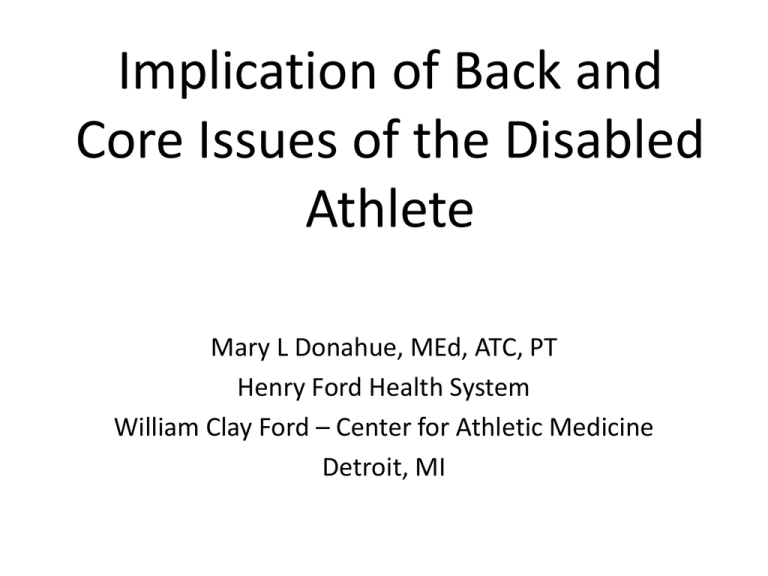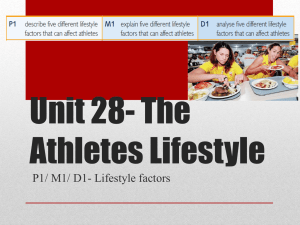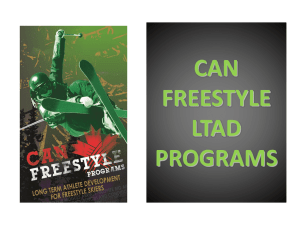Implication of Back and Core Issues of the Disabled Athlete
advertisement

Implication of Back and Core Issues of the Disabled Athlete Mary L Donahue, MEd, ATC, PT Henry Ford Health System William Clay Ford – Center for Athletic Medicine Detroit, MI Sports for the Disabled Athletes Participation in sports is based on the disability or diagnosis in these general categories: Amputations Blind or Visually Impaired Cerebral Palsy Deaf or Hearing impaired Intelligently Impaired Spinal Cord Injuries Les Autres – “The Others” Those who do not fit in the above categories. Competition Athletes compete in the local, regional, national and international levels Paralympics Games are the pinnacle of sports for disabled athlete and are recognized by the USOC Deaf athletes compete in the Deaflympics Intelligently Impaired athletes compete in the Special Olympics Deaflympics The first organized international disabled sport competition was held in 1924 in Paris for athletes with hearing impairment or deafness Longest reigning international games outside the Olympics 4000 athletes and officials from 77 countries competed in Taipei during the summer games 600 athletes and officials were at the winter games in Salt Lake City, 2007 Special Olympics Special Olympics were founded in 1968 by Eunice Shriver and were for athletes with Intellectual Disabilities The first International games were held in 1977 in Colorado and are held every 2 years alternation summer and winter games 2500 athletes from 100 countries competed in the 2009 winter games and 7500 from 165 countries complete in the 2007 summer games Sport for the Physical Disabled Athlete Sir Ludwig Guttmann the “Father” of Disabled Sports Instituted sports as a component of rehab of spinal cord injured service men/women in 1944 Sir Guttmann felt sport participation was as important for the patients as learning proper skin/bladder care. First competition for disabled athletes was held in 1948 Athletes with Physical Disabilities Archery was the first sport, followed by track Swimming, track and field were soon added as well as wheelchair basketball The Early “Olympics for the Paralyzed” The Paralympics Held in 1960 in Rome with 400 athletes from 23 countries and were the precursor of the Paralympics games Paralympics are from the word Para in Greek meaning “attached to” the Olympic The first “Paralympic Games were held in Japan in 1964 Paralympics were held in most of the same countries as the Olympics between 1960 – 1984 Seoul was the first Olympic host city which was also the host city for the Paralympics. Since 1988 a host city must submit a bid to host both the Olympic and Paralympic Games The Beijing games hosted 3951 athletes from 146 countries The opening ceremonies of the Vancouver games is March 12 - today Paralympic Athletes are those with the following disabilities/diagnoses Amputations Les Autres (the others) Traumatic Disease Muscular Dystrophy Multiple Sclerosis Ehler’s Danlos Syndrome Arthrogryposis Blindness/Visual impairment Cerebral Palsy Dwarfism Friedreich's ataxia Osteogenesis Imperfecta Spinal Cord Injuries Traumatic Disease Spina Bifida The Athletes are represented by these organizations in the USA Classification System Designed to equalize competition By Disability Spinal Cord: based on motor innervations Amputation: based on level of limb loss Blind: based on level of vision loss or total blindness Cerebral Palsy: most complicated, based on presentation , type of CP and involvement Classification System Designed to equalize competition Based on Function Athletic competition is classified within a sport to create an situation where those with similar level of disabilities are matched There are several different sport specific classification systems Summer Paralympic Sports Archery Athletics Boccia Cycling Equestrian Football 5-a-side Football 7-a -side Goalball Judo Powerlifting Rowing Sailing Shooting Swimming Table Tennis Volleyball Sitting Wheelchair Basketball Wheelchair Dance Sport Wheelchair Rugby Wheelchair Tennis Paralympic Winter sports • • • • • Alpine Skiing Biathlon Cross Country Skiing Ice Sledge Hockey Wheelchair Curling Injuries by Disability Group Blind Athletes More prone to lower extremity injuries Injuries occur from normal sport activities, but also from a lack of proprioception Goalball injuries are to shoulder and head Injuries by Disability Group Wheelchair Athletes Majority of injuries are to the upper extremity Prone to overuse injuries due Secondary problems due to disability Autonomic Dysreflexia Thermoregulatory Skin breakdowns Osteoporosis/osteopenia Injuries by Disability Group Amputee Athletes Lower limb strains and sprains Low back pain Injuries to the intact limb Injures to the amputated limb due to osteopenia/osteoporosis Injuries by Disability Group Cerebral Palsy Athlete Injuries to the knees and shoulder are the most common Patellofemoral syndrome frequently occurs with ambulatory athletes Injuries by Disability Group Special Olympic Athlete Congenital problems with Atlanto-axial joint and cardiac malformation Hypermobility of joints General deconditioning Case Presentation • Amputee track athlete • Blind Athlete Case Presentation • Wheelchair Athlete • Cerebral Palsy Athlete Bibliography • • • • • 1. Scruton L. Sir Ludwig Guttmann: creator of a world sports movement for the paralysed and other disabled Paraplegia. 1979 May;17(1):52-5. 2. Klenck C, Gebke K. Practical management: common medical problems in disabled athletes Clin J Sport Med. 2007 Jan;17(1):55-60. 3. Schaefer RS, Proffer DS, Sports medicine for wheelchair athletes Am Fam Physician. 1989 May;39(5):239-45. 4.Reynolds J, Stirk A, Thomas A, Geary F, Paralympics-Barcelona 1992 J Sports Med. 1994 Mar;28(1):14-7 5. Ferrara MS, Peterson CL Injuries to athletes with disabilities: identifying injury patterns. Sports Med.2000 Aug;30(2):137-43. Bibliography, cont • 6.Ramirez M, Yang J, Bourque L, Javien J, Kashani S, Limbos MA, Peek-Asa C. Sports injuries to high school athletes with disabilities Pediatrics. 2009 Feb;123(2):690-6. • 7.Webborn N, Willick S, Reeser JC Injuries among disabled athletes during the 2002 Winter Paralympic Games Med Sci Sports Exerc. 2006 May;38(5):811-5. • 8.Nyland J, Snouse SL, Anderson M, Kelly T, Sterling JC Soft tissue injuries to USA paralympians at the 1996 summer games Arch Phys Med Rehabil. 2000 Mar;81(3):368-73. • 9.Ferrara MS, Buckley WE, McCann BC, Limbird TJ, Powell JW, Robl R The injury experience of the competitive athlete with a disability: prevention implications Med Sci Sports Exerc. 1992 Feb;24(2):184-8. Bibliography, cont • 16.Bergeron JW.Carl D Athletes with disabilities.Phys Med Rehabil Clin N Am. 1999 Feb;10(1):213-28 • 17.Dec KL, Sparrow KJ, McKeag DB The physically-challenged athlete: medical issues and assessment Sports Med. 2000 Apr;29(4):245-58. • 18.Black SA Triathlon participation for the physically challenged athlete: medical considerations Curr Sports Med Rep. 2007 Jun;6(3):195-9. • 19.Birrer RB The Special Olympics athlete: evaluation and clearance for participation Clin Pediatr 2004 NovDec;43(9):777-82. • 20.Sanyer ON Down syndrome and sport participation Curr Sports Med Rep. 2006 Dec;5(6):315-8. • 21.Carroll KL, Leiser J, Paisley TS Cerebral palsy: physical activity and sport Curr Sports Med Rep. 2006 Dec;5(6):319-22. Bibliography, cont • 22.Palmer T, Weber KM The deaf athlete Curr Sports Med Rep 2006 Dec;5(6):323-6. • 23.Schroeder EL, Lavallee ME Ehlers-Danlos Syndrome in athletes Curr Sports Med Rep. 2006 Dec;5(6):327-34. • 24.Groah SL, Lanig IS Neuromusculoskeletal syndromes in wheelchair athletes Semin Neurol. 2000;20(2):201-8. • 25.Nilsen R, Nygaard P, Bjørholt PG Complications that may occur in those with spinal cord injuries who participate in sport Paraplegia. 1985 Jun;23(3):152-8. • 26.Stotts KM Health maintenance: Athletes and Nonathletes Arch Phys Med Rehabil. 1986 Feb;67(2):109-14. Bibliography, cont • 27.Wilson S Influence of the International Classification of Functioning, Disability and Health on Paralympic sports classification Rehabil Med. 2009 Nov;41(13):1104. • 28.Gold JR, Gold MM Access for all: the rise of the Paralympic Games J R Soc Promot Health. 2007 May;127(3):133-41... • 29.Leggat PA, Shaw MT From Sydney to Athens: preparing for the Olympic and Paralympic Games Travel Med Infect Dis. 2003 Nov;1(4):201-3. • 30.Jacob T, Hutzler Y Sports Medicine Assessment for the Athletes with a Disability Disabil Rehabil. 1998 Mar;20(3):116-9. • 31.Vanlandewijck YJ Sport science in the Paralympic movement. Rehabil Res Dev. 2006 Nov-Dec;43(7):xvii-xxiv.







